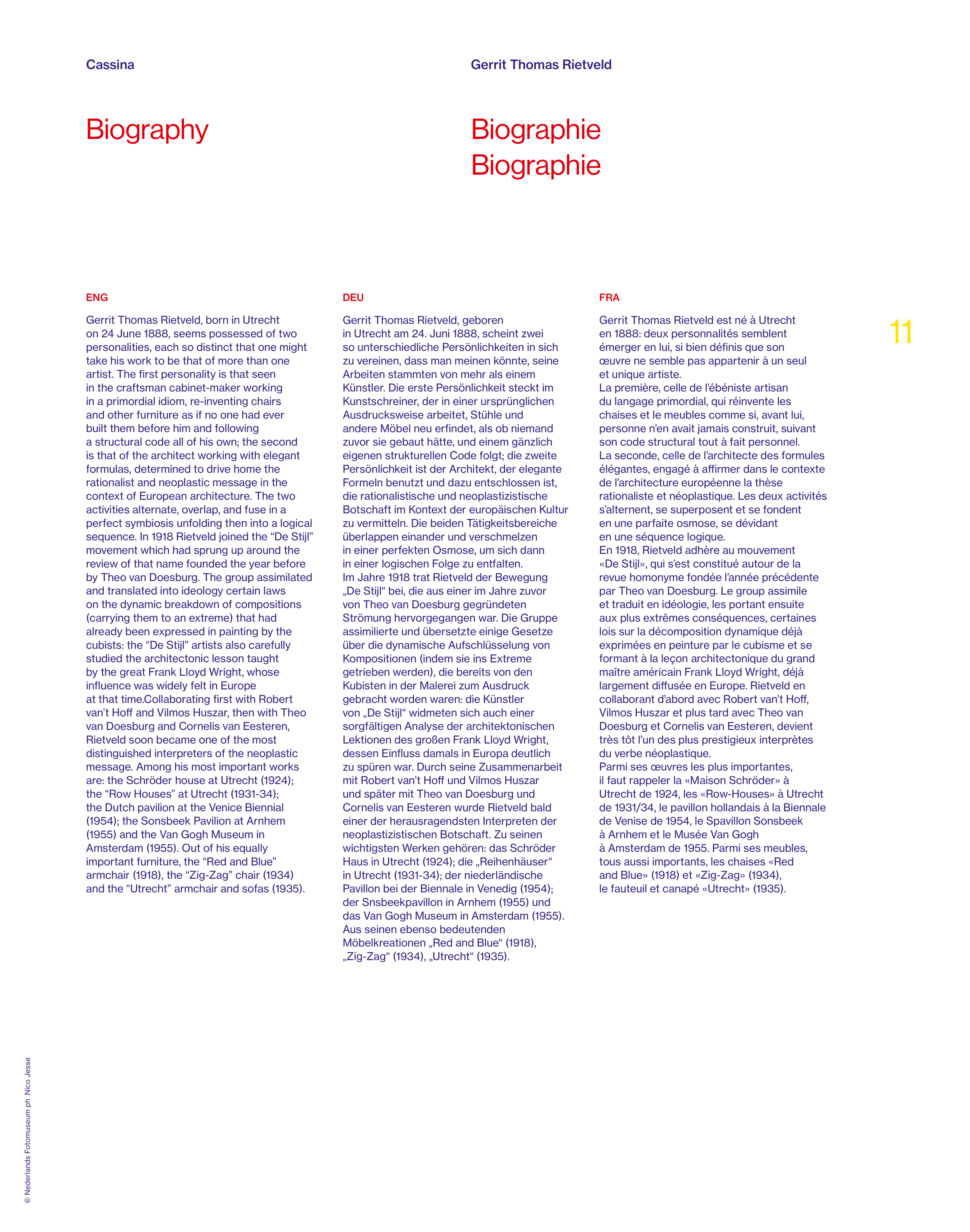Biography
Biographie
Biographie
Gerrit Thomas Rietveld, born in Utrecht
on 24 June 1888, seems possessed of two
personalities, each so distinct that one might
take his work to be that of more than one
artist. The fi rst personality is that seen
in the craftsman cabinet-maker working
in a primordial idiom, re-inventing chairs
and other furniture as if no one had ever
built them before him and following
a structural code all of his own; the second
is that of the architect working with elegant
formulas, determined to drive home the
rationalist and neoplastic message in the
context of European architecture. The two
activities alternate, overlap, and fuse in a
perfect symbiosis unfolding then into a logical
sequence. In 1918 Rietveld joined the “De Stijl”
movement which had sprung up around the
review of that name founded the year before
by Theo van Doesburg. The group assimilated
and translated into ideology certain laws
on the dynamic breakdown of compositions
(carrying them to an extreme) that had
already been expressed in painting by the
cubists: the “De Stijl” artists also carefully
studied the architectonic lesson taught
by the great Frank Lloyd Wright, whose
infl uence was widely felt in Europe
at that time.Collaborating fi rst with Robert
van’t Hoff and Vilmos Huszar, then with Theo
van Doesburg and Cornelis van Eesteren,
Rietveld soon became one of the most
distinguished interpreters of the neoplastic
message. Among his most important works
are: the Schröder house at Utrecht (1924);
the “Row Houses” at Utrecht (1931-34);
the Dutch pavilion at the Venice Biennial
(1954); the Sonsbeek Pavilion at Arnhem
(1955) and the Van Gogh Museum in
Amsterdam (1955). Out of his equally
important furniture, the “Red and Blue”
armchair (1918), the “Zig-Zag” chair (1934)
and the “Utrecht” armchair and sofas (1935).
Gerrit Thomas Rietveld est né à Utrecht
en 1888: deux personnalités semblent
émerger en lui, si bien défi nis que son
œuvre ne semble pas appartenir à un seul
et unique artiste.
La première, celle de l’ébéniste artisan
du langage primordial, qui réinvente les
chaises et le meubles comme si, avant lui,
personne n’en avait jamais construit, suivant
son code structural tout à fait personnel.
La seconde, celle de l’architecte des formules
élégantes, engagé à affi rmer dans le contexte
de l’architecture européenne la thèse
rationaliste et néoplastique. Les deux activités
s’alternent, se superposent et se fondent
en une parfaite osmose, se dévidant
en une séquence logique.
En 1918, Rietveld adhère au mouvement
«De Stijl», qui s’est constitué autour de la
revue homonyme fondée l’année précédente
par Theo van Doesburg. Le group assimile
et traduit en idéologie, les portant ensuite
aux plus extrêmes conséquences, certaines
lois sur la décomposition dynamique déjà
exprimées en peinture par le cubisme et se
formant à la leçon architectonique du grand
maître américain Frank Lloyd Wright, déjà
largement diff usée en Europe. Rietveld en
collaborant d’abord avec Robert van’t Hoff ,
Vilmos Huszar et plus tard avec Theo van
Doesburg et Cornelis van Eesteren, devient
très tôt l’un des plus prestigieux interprètes
du verbe néoplastique.
Parmi ses œuvres les plus importantes,
il faut rappeler la «Maison Schröder» à
Utrecht de 1924, les «Row-Houses» à Utrecht
de 1931/34, le pavillon hollandais à la Biennale
de Venise de 1954, le Spavillon Sonsbeek
à Arnhem et le Musée Van Gogh
à Amsterdam de 1955. Parmi ses meubles,
tous aussi importants, les chaises «Red
and Blue» (1918) et «Zig-Zag» (1934),
le fauteuil et canapé «Utrecht» (1935).
Gerrit Thomas Rietveld, geboren
in Utrecht am 24. Juni 1888, scheint zwei
so unterschiedliche Persönlichkeiten in sich
zu vereinen, dass man meinen könnte, seine
Arbeiten stammten von mehr als einem
Künstler. Die erste Persönlichkeit steckt im
Kunstschreiner, der in einer ursprünglichen
Ausdrucksweise arbeitet, Stühle und
andere Möbel neu erfi ndet, als ob niemand
zuvor sie gebaut hätte, und einem gänzlich
eigenen strukturellen Code folgt; die zweite
Persönlichkeit ist der Architekt, der elegante
Formeln benutzt und dazu entschlossen ist,
die rationalistische und neoplastizistische
Botschaft im Kontext der europäischen Kultur
zu vermitteln. Die beiden Tätigkeitsbereiche
überlappen einander und verschmelzen
in einer perfekten Osmose, um sich dann
in einer logischen Folge zu entfalten.
Im Jahre 1918 trat Rietveld der Bewegung
„De Stijl“ bei, die aus einer im Jahre zuvor
von Theo van Doesburg gegründeten
Strömung hervorgegangen war. Die Gruppe
assimilierte und übersetzte einige Gesetze
über die dynamische Aufschlüsselung von
Kompositionen (indem sie ins Extreme
getrieben werden), die bereits von den
Kubisten in der Malerei zum Ausdruck
gebracht worden waren: die Künstler
von „De Stijl“ widmeten sich auch einer
sorgfältigen Analyse der architektonischen
Lektionen des großen Frank Lloyd Wright,
dessen Einfl uss damals in Europa deutlich
zu spüren war. Durch seine Zusammenarbeit
mit Robert van’t Hoff und Vilmos Huszar
und später mit Theo van Doesburg und
Cornelis van Eesteren wurde Rietveld bald
einer der herausragendsten Interpreten der
neoplastizistischen Botschaft. Zu seinen
wichtigsten Werken gehören: das Schröder
Haus in Utrecht (1924); die „Reihenhäuser“
in Utrecht (1931-34); der niederländische
Pavillon bei der Biennale in Venedig (1954);
der Snsbeekpavillon in Arnhem (1955) und
das Van Gogh Museum in Amsterdam (1955).
Aus seinen ebenso bedeutenden
Möbelkreationen „Red and Blue“ (1918),
„Zig-Zag“ (1934), „Utrecht“ (1935).
ENG
DEU
FRA
© Nederlands Fotomuseum ph .Nico Jesse
11
Cassina
Gerrit Thomas Rietveld


